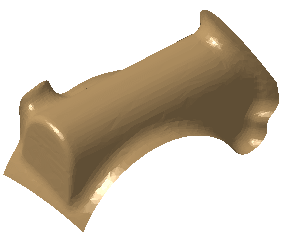 |
This task shows you how to flip
edges of triangles of a mesh, for a better respect of sharp edges,
by rotating the triangles common edges without modifying their vertices.
The meshing may become less harmonious but will provide a better respect of
the shape of the part
because the triangles will be oriented in the direction of the shape, in
particular for sharp edge fillets.
This is particularly important for milling operations that may follow.
This action reorganizes the meshing without modifying the geometry
because the vertices are not recomputed. |
 |
- The new mesh inherits the graphic properties and display mode of the
initial mesh.
- During the process, the mesh is displayed in Flat Shading mode.
- This action cannot be used on meshes with non-manifold edges.
- Undo/Redo are available.
- You may create several Flip_Edge.x elements in the specification tree,
corresponding to various degrees of reorganization of a given mesh.
You may then delete any of them, according to your needs.
|
 |
Open the
Flipedge.CATPart model the from the samples directory. |

|
-
For a better view, set the View>Cloud
Display Options to Flat.
-
Click Flip Edges
 and select the mesh. The dialog box is displayed.
and select the mesh. The dialog box is displayed.

-
Eventually, set the value of Depth, that
determines the amplitude of the reorganization of the mesh:
-
The value of Depth ranges from 0 to 10.
-
The default value is 2.
-
When the value of Depth is 0, the action
processes a triangle and its direct neighbors.
-
When the value of Depth is 1, the action
processes a triangle, its direct neighbors and their direct
neighbors,
and so on as you increase the value of Depth.
-
This may lead to a temporary degradation of the
energy function of the mesh, but results in a final optimal
solution.
-
The computation time depends on the value of
Depth, and on the size of the mesh to process.
|
-
Click Apply to start the first reorganization
iteration.
Click Apply again to start another iteration. You may repeat
this step as many times as you wish.

-
Click OK to validate the result. A
Flip_Edge.x element is created in the specification tree.
The initial mesh is sent to the No Show.
|
|

|
![]()